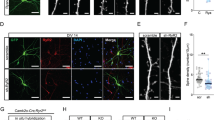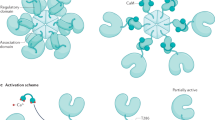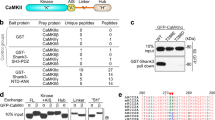Abstract
Calcium/calmodulin kinase type II (CaMKII) is a major postsynaptic density protein. CaMKII is postulated to act as a ‘molecular switch’, which, when triggered by a transient rise in calcium influx, becomes active for prolonged periods because of its ability to autophosphorylate. We studied experience-dependent plasticity in the barrel cortex of mice carrying a point mutation of the α-CaMKII gene (T286A), which abolishes this enzyme's ability to autophosphorylate. Plasticity was prevented in adult and adolescent mice homozygous for the mutation, but was normal in heterozygotes and wild-type littermates. These results provide evidence that the molecular switch hypothesis is valid for neocortical experience-dependent plasticity.
This is a preview of subscription content, access via your institution
Access options
Subscribe to this journal
Receive 12 print issues and online access
$209.00 per year
only $17.42 per issue
Buy this article
- Purchase on Springer Link
- Instant access to full article PDF
Prices may be subject to local taxes which are calculated during checkout





Similar content being viewed by others
References
Malinow, R., Schulman, H. & Tsien, R. W. Inhibition of postsynaptic PKC or CaMKII blocks induction but not expression of LTP. Science 245, 862–866 (1989).
Malenka, R. C., Kauer, J. A., Zucker, R. S. & Nicoll, R. A. Postsynaptic calcium is sufficient for potentiation of hippocampal synaptic transmission. Science 242, 81– 84 (1988).
Bhalla, U. S. & Iyengar, R. Emergent properties of networks of biological signaling pathways. Science 283, 381–387 (1999).
Kennedy, M. B., Bennett, M. K. & Erondu, N. E. Biochemical and immunochemical evidence that the “major postsynaptic density protein” is a subunit of a calmodulin-dependent protein kinase. Proc. Natl. Acad. Sci. USA 80, 7357–7361 (1983).
Miller, S. G. & Kennedy, M. B. Distinct forebrain and cerebellar isozymes of type II Ca2+/calmodulin-dependent protein kinase associate differently with the postsynaptic density fraction. J. Biol. Chem. 260, 9039–9046 (1985).
Silva, A. J., Stevens, C. F., Tonegawa, S. & Wang, Y. Deficient hippocampal long-term potentiation in alpha-calcium-calmodulin kinase II mutant mice. Science 257, 201– 206 (1992).
Kirkwood, A., Silva, A. & Bear, M. F. Age-dependent decrease of synaptic plasticity in the neocortex of alphaCaMKII mutant mice. Proc. Natl. Acad. Sci. USA 94, 3380–3383 (1997).
Giese, K. P., Fedorov, N. B., Filipkowski, R. K. & Silva, A. J. Autophosphorylation at Thr286 of the alpha calcium-calmodulin kinase II in LTP and learning. Science 279, 870– 873 (1998).
Lisman, J. A mechanism for memory storage insensitive to molecular turnover: a bistable autophosphorylating kinase. Proc. Natl. Acad. Sci. USA 82, 3055–3057 (1985).
Lisman, J. & Goldring, M. Evaluation of a model of long-term memory based on the properties of the Ca2+/calmodulin-dependent protein kinase. Journal de Physiologie 83, 187–197 (1988).
Lisman, J. A mechanism for the Hebb and the anti-Hebb processes underlying learning and memory. Proc. Natl. Acad. Sci. USA 86, 9574 –9578 (1989).
Fukunaga, K., Muller, D. & Miyamoto, E. Increased phosphorylation of Ca2+/calmodulin-dependent protein kinase II and its endogenous substrates in the induction of long-term potentiation. J. Biol. Chem. 270, 6119– 6124 (1995).
Ouyang, Y., Kantor, D., Harris, K. M., Schuman, E. M. & Kennedy, M. B. Visualization of the distribution of autophosphorylated calcium/calmodulin-dependent protein kinase II after tetanic stimulation in the CA1 area of the hippocampus. J. Neurosci. 17, 5416–5427 (1997).
Ouyang, Y., Rosenstein, A., Gabriel, K., Schuman, E. R. & Kennedy, M. B. Tetanic stimulation leads to increased accumulation of Ca2+/calmodulin-dependent protein kinase II via dendritic protein synthesis in hippocampal neurons J. Neurosci. 19, 7823–7833 (1999).
Fox, K. The cortical component of experience-dependent synaptic plasticity in rat barrel cortex. J. Neurosci. 14, 7665– 7679 (1994).
Wallace, H. & Fox, K. The effect of chessboard deprivation pattern on potentiation and depression of vibrissae responses in rat barrel cortex. Somatosens. Mot. Res. 16, 122– 138 (1999).
Glazewski, S., McKenna, M., Jacquin, M. & Fox, K. Experience-dependent depression of vibrissae responses in rat barrel cortex. Eur. J. Neurosci. 10, 2107–2116 (1998).
Glazewski, S., Chen, C.-H., Silva, A. & Fox, K. The requirement for αCAMKII in experience-dependent plasticity of the barrel cortex. Science 272, 421–423 (1996).
Miller, S. G. & Kennedy, M. B. Regulation of brain type II Ca2+/calmodulin-dependent protein kinase by autophosphorylation: a Ca2+-triggered molecular switch. Cell 44, 861–870 (1986).
Glazewski, S. et al. Impaired experience-dependent plasticity in barrel cortex of mice lacking the alpha and delta isoforms of CREB. Cereb. Cortex 9, 249–256 (1999).
Welker, E. et al. Altered sensory processing in the somatosensory cortex of the mouse mutant barrelless. Science 27, 1864–1867 (1996).
Fox, K., Schlaggar, B. L., Glazewski, S. & O'Leary, D. M. M. Glutamate blockade at cortical synapses disrupts development of thalamocortical and columnar organization in somatosensory cortex. Proc. Natl. Acad. Sci. USA 93, 5584–5589 (1996).
Strack, S., Barban, M. A., Wadzinski, B. E. & Colbran, R. J. Differential activation of post-synaptic density associated and soluble Ca2+/calmodulin-dependent protein kinase II by protein phosphatase 1 and 2A. J. Neurochem. 68, 2119– 2128 (1997).
Shen, K. & Meyer, T. Dynamic control of CaMKII translocation and localization in hippocampal neurons by NMDA receptor stimulation. Science 284, 162–166 (1999).
Barria, A., Muller, D., Derkach, V., Griffith, L. C. & Soderling, T. R. Regulatory phosphorylation of AMPA-type glutamate receptors by CaM-KII during long-term potentiation Science 276, 2042–2045 (1997).
Mammen, A. L., Kameyama, K., Roche, K. W. & Huganir, R. L. Phosphorylation of the alpha-amino-3-hydroxy-5-methylisoxazole4-propionic acid receptor GluR1 subunit by calcium/calmodulin-dependent kinase II. J. Biol. Chem. 272, 32528–32533 (1997).
Derkach, V., Barria, A. & Soderling, T. R. Ca2+/calmodulin-kinase II enhances channel conductance of alpha-amino-3-hydroxy-5-methyl-4-isoxazolepropionate type glutamate receptors. Proc. Natl Acad Sci. USA 96, 3269–3274 (1999).
Hendry, S. H. & Kennedy, M. B. Immunoreactivity for a calmodulin-dependent protein kinase is selectively increased in macaque striate cortex after monocular deprivation. Proc. Natl. Acad. Sci. USA 83, 1536–1541 (1986).
Gordon, J. A., Cioffi, D., Silva, A. J. & Stryker, M. P. Deficient plasticity in the primary visual cortex of alpha-calcium/calmodulin-dependent protein kinase II mutant mice. Neuron 17, 491– 499 (1996).
Hinds, H. L., Tonegawa, S. & Malinow, R. CA1 long-term potentiation is diminished but present in hippocampal slices from alpha-CaMKII mutant mice. Learn. Mem. 5, 344–354 (1998).
Benson, D. L., Isackson, P. J., Hendry, S. H. & Jones E. G. Differential gene expression for glutamic acid decarboxylase and type II calcium-calmodulin-dependent protein kinase in basal ganglia, thalamus, and hypothalamus of the monkey . J. Neurosci. 11, 1540– 1564 (1991).
Benson, D. L., Isackson, P. J., Gall, C. M. & Jones E. G. Contrasting patterns in the localization of glutamic acid decarboxylase and Ca2+/calmodulin protein kinase gene expression in the rat central nervous system. Neuroscience 46, 825– 849 (1992).
Jones, E. G., Huntley, G. W. & Benson, D. L. Alpha calcium/calmodulin-dependent protein kinase II selectively expressed in a subpopulation of excitatory neurons in monkey sensory-motor cortex: comparison with GAD-67 expression. J. Neurosci. 14, 611–629 (1994).
Sik, A., Hajos, N., Gulacsi, A., Mody, I. & Freund, T. F. The absence of a major Ca2+ signaling pathway in GABAergic neurons of the hippocampus. Proc. Natl. Acad. Sci. USA 95, 3245–3250 (1998).
Liu, X. B. & Jones, E. G. Localization of alpha type II calcium calmodulin-dependent protein kinase at glutamatergic but not gamma-aminobutyric acid (GABAergic) synapses in thalamus and cerebral cortex. Proc. Natl. Acad. Sci. USA 93, 7332–7336 (1996).
Fox, K. A critical period for experience dependent plasticity in somatosensory cortex . J. Neurosci. 12, 1826– 1838 (1992).
Burgin, K. E. et al. In situ hybridization histochemistry of Ca2+/calmodulin-dependent protein kinase in developing rat brain. J. Neurosci. 10, 1788–1798 (1990).
Li, X., Glazewski, S., Lin, X., Elde, R. & Fox, K. The effect of vibrissae deprivation on follicle innervation, neuropeptide synthesis in the trigeminal ganglion and S1 barrel field cortical plasticity . J. Comp. Neurol. 357, 465– 481 (1995).
Wong-Riley, M. Changes in visual system of monocularly sutured or enucleated cats demonstrable with cytochrome oxidase histochemistry. Brain Res. 171, 11–28 (1979).
Glazewski, S. & Fox, K. The time-course of experience-dependent synaptic potentiation and depression in barrel cortex of adolescent rats. J. Neurophysiol. 75, 1714–1729 (1996).
Acknowledgements
We thank Paul Chapman and Frank Sengpiel for critical reading of the text and Mervyn McKenna for histology. This work was supported by grants from NIH NS27759 and MRC(UK) to K.F. K.P.G. was supported by the German Research Council (DFG).
Author information
Authors and Affiliations
Corresponding author
Supplementary information
Figure. Plasticity in adolescent T286A mutants
The effect of 18 days of deprivation on responses to D1 and principal vibrissae stimulation in adolescent T-286 homozygotes. Each point represents data from a single cell recorded in layers 2/3. The cell's response to the spared D1 vibrissa is plotted against its response to the deprived principal vibrissa. Equal responses from both vibrissae result in a point on the dashed line (45 degree line). Note that, in spite of deprivation, most cells are dominated by the deprived principal vibrissa. Additionally, domination of the remaining cells by the D1 vibrissa is due to depression of the deprived principal vibrissa response rather than potentiation of the D1 response. In contrast, in wild-type animals, plasticity is expressed mainly by potentiation of the D1 input (see Fig. 4 in ref. 40 for comparison). (GIF 168 kb)
Rights and permissions
About this article
Cite this article
Glazewski, S., Giese, K., Silva, A. et al. The role of α-CaMKII autophosphorylation in neocortical experience-dependent plasticity. Nat Neurosci 3, 911–918 (2000). https://doi.org/10.1038/78820
Received:
Accepted:
Issue Date:
DOI: https://doi.org/10.1038/78820
This article is cited by
-
Adnp-mutant mice with cognitive inflexibility, CaMKIIα hyperactivity, and synaptic plasticity deficits
Molecular Psychiatry (2023)
-
Age and Alzheimer’s disease gene expression profiles reversed by the glutamate modulator riluzole
Molecular Psychiatry (2017)
-
Reorganization of cortical population activity imaged throughout long-term sensory deprivation
Nature Neuroscience (2012)
-
Experience-dependent structural synaptic plasticity in the mammalian brain
Nature Reviews Neuroscience (2009)
-
The developmental origins of anxiety
Nature Reviews Neuroscience (2004)



